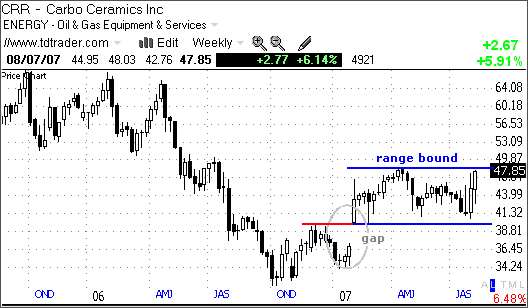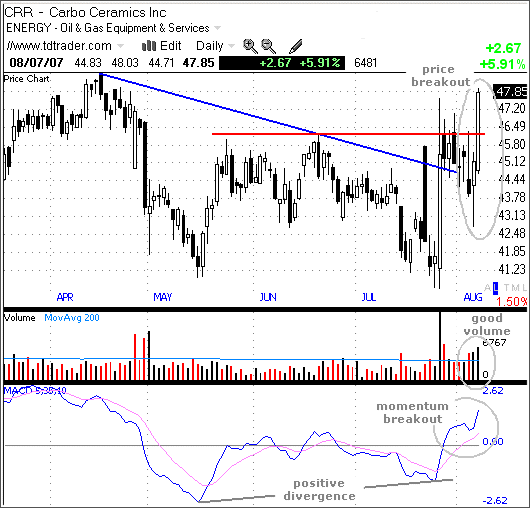
HOT TOPICS LIST
- MACD
- Fibonacci
- RSI
- Gann
- ADXR
- Stochastics
- Volume
- Triangles
- Futures
- Cycles
- Volatility
- ZIGZAG
- MESA
- Retracement
- Aroon
INDICATORS LIST
LIST OF TOPICS
PRINT THIS ARTICLE
by Arthur Hill
Carbo Ceramics remains range-bound on the weekly chart, but a high-volume breakout on the daily chart points to higher prices and a breakout on the weekly chart.
Position: Accumulate
Arthur Hill
Arthur Hill is currently editor of TDTrader.com, a website specializing in trading strategies, sector/industry specific breadth stats and overall technical analysis. He passed the Society of Technical Analysts (STA London) diploma exam with distinction is a Certified Financial Technician (CFTe). Prior to TD Trader, he was the Chief Technical Analyst for Stockcharts.com and the main contributor to the ChartSchool.
PRINT THIS ARTICLE
MACD
A Momentum Breakout For Carbo Ceramics
08/08/07 11:58:15 AMby Arthur Hill
Carbo Ceramics remains range-bound on the weekly chart, but a high-volume breakout on the daily chart points to higher prices and a breakout on the weekly chart.
Position: Accumulate
| On the weekly chart (Figure 1), Carbo Ceramics (CRR) gapped up in early February and then began a long consolidation. The stock traded between 40 and 49 from February to July with three bounces off support. In December, 40 marked resistance and the stock broke this resistance level with the gap in February. Broken resistance turned into support and the stock bounced off 40 three times in the last six months. A move above 49 would break consolidation resistance and signal a continuation of the advance from earlier this year. |

|
| FIGURE 1: CARBO CERAMICS, WEEKLY. CRR gapped up in early February and then began a long consolidation. |
| Graphic provided by: Telechart 2007. |
| |
| On the daily chart (Figure 2), we can see the power behind the recent surge as well as a breakout around 46. The stock surged at the end of July, met resistance from the May–June lows, and then consolidated in early August. This consolidation affirmed resistance around 46 and the stock broke through this key level with a surge this week. The breakout occurred on good volume, and this bullish price action points to higher prices down the road. |

|
| FIGURE 2: CARBO CERAMICS, DAILY. The stock surged at the end of July, met resistance from the May–June lows, and then consolidated in early August. |
| Graphic provided by: Telechart 2007. |
| |
| In addition to a price breakout, there is a momentum breakout as 5-35 moving average convergence/divergence (MACD) moved to its highest level since April. The traditional MACD is based on the 12- and 26-day moving averages. I elected to use the five- and 35-day moving averages for a more sensitive indicator. The five-day moving average is shorter than the 12-day, and this makes it more sensitive. In addition, the 35-day is longer than the 26-day, and this makes it less sensitive. The combination of a more sensitive five-day moving average and a less sensitive 35-day moving average produces a more crossovers. The 5-35 MACD formed a positive divergence in July and broke into positive territory in late July. The indicator continued higher in August with a break above its June highs, and momentum is once again bullish. |
Arthur Hill is currently editor of TDTrader.com, a website specializing in trading strategies, sector/industry specific breadth stats and overall technical analysis. He passed the Society of Technical Analysts (STA London) diploma exam with distinction is a Certified Financial Technician (CFTe). Prior to TD Trader, he was the Chief Technical Analyst for Stockcharts.com and the main contributor to the ChartSchool.
| Title: | Editor |
| Company: | TDTrader.com |
| Address: | Willem Geetsstraat 17 |
| Mechelen, B2800 | |
| Phone # for sales: | 3215345465 |
| Website: | www.tdtrader.com |
| E-mail address: | arthurh@tdtrader.com |
Traders' Resource Links | |
| TDTrader.com has not added any product or service information to TRADERS' RESOURCE. | |
Click here for more information about our publications!
Comments

|

Request Information From Our Sponsors
- VectorVest, Inc.
- Executive Premier Workshop
- One-Day Options Course
- OptionsPro
- Retirement Income Workshop
- Sure-Fire Trading Systems (VectorVest, Inc.)
- Trading as a Business Workshop
- VectorVest 7 EOD
- VectorVest 7 RealTime/IntraDay
- VectorVest AutoTester
- VectorVest Educational Services
- VectorVest OnLine
- VectorVest Options Analyzer
- VectorVest ProGraphics v6.0
- VectorVest ProTrader 7
- VectorVest RealTime Derby Tool
- VectorVest Simulator
- VectorVest Variator
- VectorVest Watchdog
- StockCharts.com, Inc.
- Candle Patterns
- Candlestick Charting Explained
- Intermarket Technical Analysis
- John Murphy on Chart Analysis
- John Murphy's Chart Pattern Recognition
- John Murphy's Market Message
- MurphyExplainsMarketAnalysis-Intermarket Analysis
- MurphyExplainsMarketAnalysis-Visual Analysis
- StockCharts.com
- Technical Analysis of the Financial Markets
- The Visual Investor
